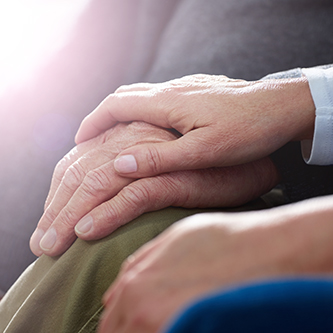
The fear of the unknown is always greater than the fear of the known.
One of the most frequent questions that is asked of our nurses is, “How long does he or she have to live?” One of the greatest sources of stress for caregivers is the onset of new or more severe symptoms as death approaches. The fear of the unknown is always greater than the fear of the known. In this respect, we offer you this information to help you to prepare for and anticipate symptoms which are indicative of approaching death. Your nurse and your physician are your best resources to help clarify your concerns about this information.
Not all of these symptoms will appear at the same time. Some may never appear. We want to relate each possible symptom to you in order to decrease your fear in case one appears suddenly. All the symptoms described are indicative of how the body prepares itself for the final stage of life… death. This is not the time to try to change the dying person, but the time to give full acceptance, support and comfort.
Signs and Symptoms of Impending Death
Sleepiness
Your loved one may begin to sleep more and may be difficult to arouse. This is partially due to metabolic changes in the body. Sit down and hold your loved one’s hand, speaking softly and naturally. Don’t shake the patient or speak loudly. Do not try to give oral medications, food or fluids to an unconscious person.
Confusion
The person may sometimes be confused about time, place or who is present in the room. Some of this may be due to changes in metabolism, changes in vision or increased sleeping. Have each visitor identify himself. Do not ask, “Do you know who I am?” Speak softly, clearly and truthfully when you need to communicate something important. Try to orient him/her to reality with familiar objects and pictures of loved ones, etc.
Vision Changes
As the person’s vision begins to fail, he/she may only see what is nearby. Use indirect lighting and sit near the head of the bed where you can be seen more easily. Remember that although vision may decrease, the sense of hearing remains. Inform all visitors that the person may be able to hear voices, although he/she may no longer be capable of responding. Encourage everyone to continue talking to the person. Do not whisper.
Decreased Appetite/Refusing Food & Fluids
As death approaches, the person may want less and less food and fluids, eventually refusing them altogether. The body is conserving energy that would be used to digest the food for other functions. Don’t force foods or fluids. Ice chips of crushed up frozen juice are often refreshing in the mouth. Chapstick or lip balm helps soothe dry lips. If oxygen is being used, use a non-petroleum based product.
Decreased Urine Output
This occurs as fluid intake decreases and as circulation through the kidneys decreases. The person may lose bladder and/or bowel control as muscles in that area begin to relax. Pads may be needed to protect the bed and keep him/her clean, dry and comfortable. If your loved one has a bladder catheter in place, you will notice that the amount of urine will decrease as death comes closer.
Periods of Apnea (no breathing)
The person may stop breathing for 15-45 seconds. There may be periods of rapid respiration alternating with periods of apnea. This is called “Cheynes-Stokes” respiration. It is very common and indicates a decrease in circulation to the internal organs and build-up in the body waste products. Elevating the head of the bed 30-45 degrees may help bring comfort.
Rattling Breathing or Wet Gurgling
Secretions in the throat or the relaxing of the throat muscles can lead to noisy breathing, sometimes called the death rattle. Repositioning the person, limiting fluid intake, or using drugs to dry secretions can minimize the noise. Such treatment is aimed at the comfort of the family or caregivers because noisy breathing occurs at a time when the dying person is unaware of it. The death rattle does not cause discomfort for the dying person. This breathing can continue for hours and often means that death will occur in hours or days.
Cool Skin
As the body shuts down, circulation diminishes to the arms and the legs and they may feel very cool to the touch. The pulse will become harder to feel. The skin color may change. The upper parts of the body may sweat as the peripheral circulation decreases. You may notice the underside of the body becoming much darker in color. Even though the skin is cold to the touch, most dying persons aren’t aware of feeling cold. Use light clothing and make sure there is fresh, circulating
air. Do not use an electric blanket. A change of position every two hours protects the skin and promotes comfort.
High Temperature
It is not unusual for a dying person to have an elevated temperature even as high as 104 degrees as they draw closer to death. Give analgesics such as Tylenol. These are available in pill, suppository and gel form. Use light clothing and cover; and apply cool moist cloths to the forehead or back of the neck.
Withdrawal
The person may seem unresponsive or withdrawn. This may be the beginning of “letting go”. Just as you are losing someone you love, the dying person is in the process of losing everyone and everything he/she loves. It is only natural to be withdrawn. If the patient is allowed to express his/her sorrow, the stage of final acceptance will be easier. If the person is unresponsive, remember hearing remains all the way to the end. Speak to your loved one in your normal tone of voice, identifying yourself by name when speaking. Hold his/her hand and say whatever you need to say that will help the person to “let go”.
Out of Character Requests or Statements
This is a sign of preparation for death. Often a certain individual’s support is most needed. If you are not a part of this “inner circle” at the end, it doesn’t mean you are unloved or unimportant. It means you have already fulfilled your task with them and it is time for you to say goodbye. If you are part of the final “inner circle” of support, the person needs your affirmation and permission.
Performing Restless, Useless, Repetitive Tasks
This sometimes indicates something is still unresolved and unfinished and they can’t let go. The care team may be able to help you identify what is happening and help discover a way for your loved one to find release from tension or fear. A dying person will try to hold on, even though it brings prolonged discomfort, in order to make sure those who are left behind will be alright.
Your ability to release your loved one from this concern and give the assurance it’s alright to let go whenever he/she is ready, is one of the greatest gifts you can give.
